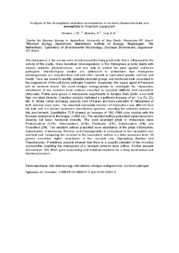Analysis of the rhizosphere microbial communities of common beans resistant and susceptible to Fusarium oxysporum.
Analysis of the rhizosphere microbial communities of common beans resistant and susceptible to Fusarium oxysporum.
Author(s): MENDES, L. W.; MENDES, R.; TSAI, S. M.
Summary: The rhizosphere is the narrow zone of soil around the living plant roots that is influenced by the activity of the plants. Many beneficial microorganisms in the rhizosphere provide plants with mineral nutrients, phytohormones, and also help to protect the plant against soil-borne pathogens. Microbiological studies are addressed to understand how rhizosphere microorganisms are recruited from soil and either benefit or harm plant growth, nutrition and health. Here, we aimed to identify potential microbial groups and functional traits correlated to the suppression of the soil borne pathogen Fusarium oxysporum, the causal agent of Fusarium wilt on common beans. We used shotgun metagenomics to investigate the rhizosphere microbiome of two common bean cultivars classified as resistant (Milênio) and susceptible (Alvorada). Plants were grown in mesocosms experiments in Amazon Dark Earth, a soil with high microbial diversity. Chemical analysis indicated a significant increase of pH, Ca, Fe, Zn, Mn, B, nitrate, cation exchange capacity, sum of bases and base saturation in rhizosphere of both common bean types. The microbial community structure of rhizosphere was different from the bulk soil in a deeper taxonomic classification (genera), revealing the selection process in this environment. Quantitative PCR showed an increase of 16S rRNA copy number with the increase resistance to the fungus in ADE soil. The resistant cultivar presented higher taxonomic diversity but lower functional diversity. The most abundant phyla in rhizosphere were Proteobacteria (41%), Actinobacteria (31%), Firmicutes (5%), Acidobacteria (3%) and Chloroflexi (3%). The resistant cultivar presented more abundance of the phyla Chlamydiae, Spirochaetes, Deinococcus-Thermus and Chrysiogenetes in comparison to the susceptible one and bulk soil. Comparing the resistant to the susceptible cultivar in a finer taxonomic level, 24 genera presented higher abundance in the resistant one, highlighting Bacillus and Pseudomonas. Preliminary analysis showed that there is a specific selection of the microbial communities inhabiting the rhizosphere of a resistant common bean cultivar. Further analysis will combine 16S rRNA gene sequencing and metatranscriptome for a deep taxonomical and functional analysis.
Publication year: 2015
Types of publication: Abstract in annals or event proceedings
Unit: Embrapa Environment
Observation
Some of Embrapa's publications are published as ePub files. To read them, use or download one of the following free software options to your computer or mobile device. Android: Google Play Books; IOS: iBooks; Windows and Linux: Calibre.
Access other publications
Access the Agricultural Research Database (BDPA) to consult Embrapa's full library collection and records.
Visit Embrapa Bookstore to purchase books and other publications sold by Embrapa.

